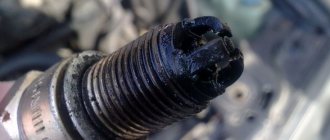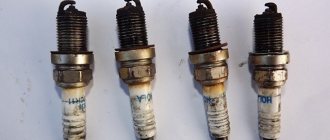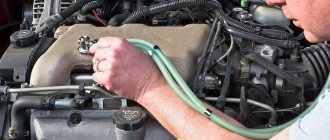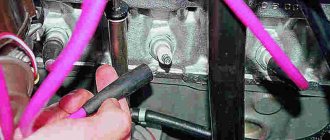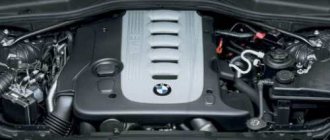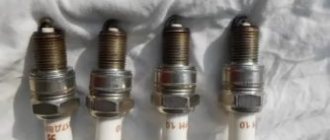Pouring spark plugs when cold is due to malfunctions in the ignition system, incorrect adjustment of the air-fuel mixture by sensors, the use of low quality fuel, a slowly rotating starter, reduced compression in one or more engine cylinders.
Typically, the engine runs on cold spark plugs during an unsuccessful start, that is, when the crankshaft rotates, but the engine cannot “catch” and start.
If you can’t start, but at the same time fuel is being injected into the combustion chamber, then the longer you turn the starter, the more difficult it will be to start and the worse the engine will be.
Any car owner can find the fault and understand why he fills the spark plugs when they are cold, regardless of whether he has a carburetor or an injector.
| engine's type | Cause of malfunction | What to do |
| Injection | Low battery | Periodic battery charging from an external charger. If the battery does not hold a charge, you will have to buy a new battery. |
| Faulty ignition system components | Check and repair/replace the following items:
| |
| Low quality fuel | Replacing fuel with high-quality fuel with the appropriate octane number. Flushing the fuel system. In extreme cases, you can use fuel additives or a quick start for a short time. | |
| Low compression | First of all, it is necessary to check the compression in all cylinders. Next, find and eliminate the cause of low compression, but to do this you will have to disassemble the engine and check the condition of the cylinders, pistons, and rings. | |
| Faulty sensors | Check and replace the following sensors if necessary:
| |
| Carburetor engine | Incorrect setting | Check the carburetor setting and adjust it accordingly if necessary. Also check the cleanliness of its internal elements, chambers, and jets. You can clean it of carbon deposits. |
| Trigger diaphragm malfunction | Replace the diaphragm with a new one |
What should a VAZ-2109 car owner do if the spark plugs are filled with fuel?
VAZ-2109 carburetor car owners can solve the problem of “filling” spark plugs in two ways:
- You can, of course, unscrew one of the spark plugs and buy exactly the same element, fully assembled, in specialized stores or at automobile markets.
- Take advantage of a more budget-friendly option and solve this problem yourself. This process is quite simple, so every car owner can cope with it if replacing and cleaning the spark plugs is carried out in stages:
- all candles must be carefully unscrewed from the so-called “sockets” and ignited under the flame of a gas burner, holding them with ordinary pliers;
- these elements need to be heated until the metal turns red in order to completely remove carbon deposits and any contaminants;
- after warming up, you need to use fine-grained sandpaper to get rid of the film that forms during the oxidation process around the connectors;
- Then all that remains is to screw the spark plugs into their original place, and the replacement process can be considered complete.
According to many experts, although such a process is considered economical, it will not help to operate thoroughly heated and cleaned components for a long time, since this process quite often damages the candle core, the basis of which is fragile ceramics. Therefore, if car owners decide on this replacement method, they must understand that, most likely, in the very near future the spark plugs may fail again, and they will have to repeat the whole process again. It is best to immediately buy a new set of components that match the markings and use them for their intended purpose. After reading this article, every owner of a VAZ-2109 carburetor will be able to independently replace the spark plugs, clean and dry them, and, of course, install them in their original place. Such an event will not take much time, and if questions or difficulties arise during the replacement, you can simply watch a video tutorial on the Internet resource, which will further simplify the replacement of failed elements.
Cleaning
If the spark plugs are dirty, then it is not at all necessary to immediately replace them with new elements of the ignition system, igniting the fuel mixture in the combustion chamber of the VAZ 2110. Regular cleaning will quickly remove the dirt and return the spark plugs to their previous functionality.
There are several common cleaning methods that can be used at service stations and in garages with your own hands.
Regardless of the chosen method, we recommend that you follow the general principles of operation when cleaning the elements of the ignition system.
- Protect the coating of the spark plugs from abrasion; do not use rough sandpaper or other similar abrasives.
- Do not expose the candle to high temperatures. It is not worth heating them over a fire for the purpose of cleaning. Some people do this for some reason.
- Check the spark plug for resistance using a megometer. If the second scale does not show + infinity, then the spark plug will have to be changed. Cleaning is useless. With a value of 1000 it is also better not to try to resuscitate the element.
Now let's talk directly about cleaning methods.
Cleaning before and after
The formation of carbon deposits and flooding will require not only removing and drying the spark plugs, but also thoroughly cleaning them.
- One popular method is to remove carbon deposits with a fine-bristled wire brush;
- Another option is treatment with kerosene, which removes carbon deposits quite effectively;
- Another method involves the use of sandblasting. The effectiveness of this approach is short-term, so you will soon have to remove the candles again and clean them;
- Many people have also gotten used to using chemical converters. To do this, candles are placed in a solution, allowed to sit for about an hour, after which they are cleaned with matches, toothpicks to remove carbon deposits, washed with water and dried;
- In order not to buy specialized products, you can use acetone using the same cleaning principle;
- Our grandfathers cleaned candles with vinegar. To do this, you will need to dip them in vinegar for an hour, then add literally 5 drops of electrolyte;
- There is an ultrasonic cleaning method, but this requires specialized equipment.
Article on the topic: How to check the speed/speedometer sensor on a VAZ 2110 and where it is located
If you do not get the desired result, you will have to change the candles. But first they need to be selected.
Wet spark plugs: causes
Based on the practice of most motorists, the following circumstances are a precursor to flooding:
Filling with low quality fuel. In winter, an important factor is the purity of gasoline from undesirable components that have a direct impact on the quality of ignition. Excessive amounts of paraffin will minimize ease of starting in such “cold” conditions. Do not forget about the presence of condensate in the tank, which collects due to temperature changes. Ignition system failures. Difficulties are created not only by candles, but also by the operation of high-voltage wiring. Old spark plugs that have been in use for a long time may have distorted gaps and defects on the body or electrodes. The consequence is that there is no spark.
It is important to monitor the performance of the system as a whole. Low battery charge. You should expect problems when the charge level is low - 40–50%
When the ambient temperature drops, not every battery is able to operate, delivering maximum power sufficient to rotate the starter and fully operate the ignition system. The result is the supply of fuel to the cylinders, however, ignition does not take place, the electrodes of the spark plugs are flooded.
In reality, what may happen is that the electronic control unit takes into account the external temperature, the current heating of the engine, the amount of oxygen in the air sent to the engine, etc. A command is sent to open the injectors, which ensures that the mixture is enriched with fuel, facilitating a cold start. At initial idle speed, the automation helps ensure stable operation/start-up of the power plant.
Such events can negatively affect engines with significant wear of the cylinder-piston group. There will be low compression inside, at the lower permissible limit. Additional negatives include a slightly shriveled battery, thick oil and soot deposits on the spark plug contacts. As a result, the consequences will be noticeable:
- low-quality gasoline flows through the injectors, which evaporates poorly due to the low ambient temperature;
- the crankshaft dipped in thick lubricant is difficult to turn by the starter;
- in a cooled engine, the cold parts do not expand, and due to the low temperature, gaps in the cylinder-piston group are noticeable and compression is reduced;
- a weak spark is generated due to the contacts of the spark plugs being contaminated with soot.
Even some of the problems from this set can lead to difficulty starting the engine or starting intermittently. Accordingly, you will have to monitor most of the listed parameters.
Symptoms of a problem
If the spark plugs fail, there will be no spark. Consequently, the fuel mixture will not be able to ignite, the engine will freeze and show no signs of life.
There are several telltale signs that may indicate poor spark plug performance.
- The engine starting procedure gets worse. The starter turns, but the motor itself does not respond;
- Fuel consumption increases;
- CO emissions increase;
- At idle and while driving, the engine begins to jerk the car;
- The dynamic performance of the car drops, it is not possible to raise the speed to the required maximum, the engine power noticeably decreases, etc.
Article on the topic: Why there is no light in the interior of the VAZ 2114: the secrets of an electrician
But all these are indirect reasons, since they do not directly indicate the failure of the spark plugs. You can verify their malfunction only by checking.
How to act to avoid trouble
- firstly, you need to monitor the battery charge level and check it periodically (this is especially true in winter);
- secondly, check the serviceability and if any problems arise, do not be lazy to go for diagnostics;
- thirdly, only the best quality, which is suitable for use in winter;
- fourthly, promptly change and inspect high-voltage wires for the fact of their probable failure;
- fifthly, regulate and. This is easy to do - add one of the special compounds that are sold in stores to the tank;
- Sixth, use high quality. To do this, refuel at trusted gas stations.
Remember that in the cold season the engine does not like small trips at low speed.
Hello, dear car enthusiasts! Maybe not all, but many motorists are faced with this problem: yesterday I arrived, put the car in the garage, everything was fine. This morning I started to start the engine, but it would not start.
There could be a number of reasons for this
But today we will look at the most common one - filling the spark plugs with gasoline, it doesn’t matter whether you have an injector or a carburetor. Fills spark plugs with gasoline regardless of the type of vehicle fuel system
It is characteristic that the spark plugs are filled with gasoline less often in the warm season, and more often at sub-zero temperatures. So let’s try to figure out in order: why the spark plugs in the injector are flooded, what to do to start the engine at the exact moment when they are flooded, and how to prevent them from being flooded with gasoline in the injector.
Reasons why the spark plugs in the injector flood
In principle, the reason why the injector spark plugs flood is simple. And the tones lie in the peculiarities of the “electronic brain” of your car.
At subzero temperatures, mixing the fuel-air mixture requires some effort: more oxygen in cold air requires more gasoline. Accordingly, the ECU gives a command to the injector nozzles to increase the fuel supply, which they do in good faith.
And the following happens in the engine, especially if your car no longer has a new battery. The injectors supply fuel to the combustion chamber, the starter tries to create the necessary compression in the cylinders, while at the same time trying to provide a spark to generate a flash. Do not forget about the quality of fuel, which does not have ideal parameters.
As a result, with ideal compression, the injector spark plugs can start even with a minimum impulse, but ideal compression is only found in a new car. Actually, this is why, as a rule, the injector spark plugs of a new car do not fill.
The spark is weak, compression in the cold does not correspond to the parameters, and the injectors continue to supply fuel to the combustion chamber. Which, in turn, floods the candles and they simply stop showing signs of fiery life.
This is the answer to the question - why are they filled in on the injector?
There are two options for resolving the issue. As a rule, the “smart” operating book says: if the injector spark plugs are filled with gasoline, you need to unscrew them and dry them. With the spark plugs removed, crank the starter for 10-15 seconds. Put it back in and start the engine. These are actions according to the manufacturer.
A proven popular driving method. If your spark plugs are filled with gasoline, before unscrewing and drying them, try to start the engine in the following way: purge mode.
For the injector: the gas pedal is pressed all the way to the floor. Use the starter to crank the engine for 10-12 seconds, release the gas pedal. The engine should start. The fact is that in this way, by cutting off the fuel supply, you blow air through the spark plugs.
The engine did not start. Then try to dry them. Spark plugs for an injector are, in principle, no different from a carburetor engine. Therefore, we again use the “old-fashioned” method: we unscrew them, clean them from carbon deposits with a metal brush, or a toothbrush, and dry them either with a hairdryer, or on a gas stove or in the oven. We check the gap and screw the spark plugs for the injector into place. The engine should start.
If the story of filling the spark plugs with gasoline repeats itself every morning, you need to carry out diagnostics: spark plug quality, injector cleanliness, spark output from the ignition coil, Hall sensor.
Features of starting a car in cold periods
In cold weather, before starting, you must first load the battery, then disconnect it for a while. After waiting a few minutes, you can try turning the starter to start the engine. If you fail to start the car on the first try, then in order not to fill the injector, you must wait a few more minutes. If all preventive measures were carried out in full before the frost, then there should be no problems with filling fuel.
We can list several conditions that are considered optimal for normal operation of the injector:
- presence of a working starter;
- maximum battery charge. The battery is powerful and in good condition;
- seasonal lubricant is used;
- spark plugs and high voltage electrical circuits must be in perfect condition;
- clean, adjusted nozzles are installed;
- The gas tank is filled with high-quality fuel.
There is an opinion among experienced drivers that driving a car along a highway at a speed of 120 km/h promotes self-cleaning of automobile systems, including the fuel system. You can also run the engine at 5000 rpm for about 10 minutes in the morning. The effect is similar to racing on a track.
It is believed that when high pressure is created in the systems, self-cleaning occurs. These measures can only be carried out if the car is in good condition and a significant increase in pressure in the systems will not harm it.
What steps do you need to take to get started?
The question arises, what to do if the car is not old, all systems are in order, but in the cold it refuses to start? When turning the spark plugs out, it turns out that they are wet. As already mentioned, in the cold season, the cause of this phenomenon may be weak compression, low-quality fuel or a weak battery.
Let's look again at the manufacturer's instructions. The book on car operation defines the following algorithm of actions:
- Turn out the spark plugs.
- Wipe them thoroughly and dry them.
- Run the starter for a few seconds.
- Put everything in place.
Often, car owners clean the injector using various fuel additives. This is not recommended at all, firstly, the quality of the fuel mixture is lost, which negatively affects the operation of the entire piston group, and secondly, the injector should be cleaned using special equipment.
Experienced drivers carry several sets of spare spark plugs with them . The quality of the spark produced depends on the technical characteristics of this ignition component. There is no point in saving on candles, their cost is not that high, and low-quality candles can cause a lot of problems.
Prevention
For normal operation of the ignition system, it is necessary to create certain conditions for the engine, especially in winter, under cold start conditions:
- before cold weather, change the spark plugs (it’s better to carry a good old set with you for replacement in case of filling), change the fuel filter, service the battery;
- monitor the battery charge, charge the battery;
- monitor the serviceability of the starter and prevent it from jamming;
- promptly, once every 100 thousand km, clean injection nozzles on a special stand;
- change the engine oil according to the regulations, if necessary, flush the lubrication system with decoking of the piston rings;
- regularly check the condition of the spark plugs, change them to platinum or iridium every 15-20 thousand km;
- choose high-quality gasoline with the maximum permissible octane number, keep the tank full in winter;
- Remember that prolonged operation of the engine in IAC, driving at low revs, at low speed, and insufficient engine warming up lead to carbon deposits. Drive onto highways, “spinning” the engine to 3500-5000 rpm so that carbon deposits and deposits burn out in the chamber and the spark plugs are cleaned.
Our dismantling shop offers high-quality spare parts for your car.
Go to search
Tags: fault diagnosis
What to do if the candles are flooded.
How to start a car if the engine spark plugs are flooded. In the case where the spark plugs are wet from gasoline in an injection engine, you should unscrew the spark plugs, hold them on the fire with pliers (dry them), and turn the starter without installed spark plugs for about 10 seconds to ventilate the pistons. After this, the spark plugs are tightened and, as a rule, the car starts.
How to dry the cylinders without unscrewing the spark plugs in the injector
Dry the cylinders in this order:
- The gas pedal is pressed all the way to the maximum.
- Turn the ignition key and turn the starter for about 10 seconds.
- Release the gas pedal.
If the gas pedal is pressed, the throttle valve is open, due to which air circulates and the spark plugs dry out.
In this simple way, you can start a fuel-injected car after filling the spark plugs with gasoline.
If the method of drying without dismantling the candles does not help, then you will have to dry the candles manually. Manual cleaning is better, since the electrode itself can also be quickly cleaned of carbon deposits and heated over a fire, and the gap can be checked.
Spark plugs are not expensive; those who don’t want to bother and clean them buy new ones that are appropriate for the given engine.
The service life of spark plugs is from 15 to 25 thousand kilometers.
If simple minor repairs and simple actions to eliminate this cause do not help, then it is necessary to carry out in-depth diagnostics: checking the ignition system, ignition coil, injectors, temperature sensor, Hall sensor.
Let's decide what this means and why it happens?
It's no secret that an internal combustion engine is a rather complex device in which several sequential processes take place. The first process is the supply of a fuel-air mixture, during which fuel is mixed with air and enters the engine cylinders. The second is the compression of the said mixture by the cylinders, by raising the piston as high as possible with the valves closed. The third is ignition: a spark is supplied to the cylinders, where the fuel-air mixture is under pressure, provoking a mini-explosion, ignition of the said mixture and the downward movement of the piston. The fourth process is the release of exhaust gases through a piston and valves into the gas exhaust system.
This is how the internal combustion engine operates under normal conditions, but in winter (in the cold) failures may occur in this sequential cycle.
Due to the fact that cold air is much more enriched in oxygen than warm air, a larger volume of fuel is required to ignite it. The ECU knows about this and sends the appropriate command to the injectors. They, in turn, send an upwardly adjusted amount of fuel into the combustion chamber, where at this time the starter tries to simultaneously create good compression and give a spark to generate a flash. Taking into account the poor quality of gasoline at our gas stations and the presence of some wear and tear on parts (we are not talking about new cars here, because the compression in them is ideal, so the question is: the spark plugs are flooded, what should I do? –
It’s just not worth it), he doesn’t always manage to do it well. As a result, the mixture does not ignite, and the fuel supplied to create a chemical reaction floods the candles, completely paralyzing their work. This can happen for only 2 reasons:
- due to an overly simple and already outdated injection system in carburetor engines, in which there is no measure of fuel supply (even if the car does not start, the system will continue to “pour” gasoline in the amount “prescribed” in the settings), as well as its incorrect settings;
- (found on both a carburetor car and an injector) due to a weak battery, which at low temperatures is simply not able to create the necessary voltage to ignite a spark.
When the air temperature drops below 15 degrees, motorists often do not start the engine in the morning. There are many reasons why this happens. One of them is fuel getting on the spark plugs. Moreover, this can happen with both carburetor and fuel injection systems. To solve this problem, you need to figure out why the spark plugs on the injector are flooded and what needs to be done to avoid this. I will talk about this in this article.
Let's first look at the reasons why the spark plugs on the injector are flooded. To do this, consider the operation of a car starter. Thanks to the operation of its pistons and valves, a mixture of gasoline and air is supplied to the combustion chamber, which is ignited by a spark generated by the spark plugs. After ignition, the starter turns off. Thanks to ignition, the engine cylinders start working. To successfully start the engine, you need a working starter, a powerful battery and a favorable ambient temperature.
At low temperatures, gasoline does not mix well with air. It is known that frosty air contains more oxygen. An increase in oxygen content requires the supply of more gasoline. The vehicle's electronic control unit sends a signal to the fuel injectors, which increases the fuel supply. Thanks to the starter, compression is created in the cylinders and at the same time a spark is formed to ignite the fuel mixture. But since the compression does not meet the standards and the spark is weak, the incoming gasoline will flood the spark plugs, preventing the mixture from igniting. This is the reason why candles are poured in cold weather.
The formation of a spark is influenced by the following factors:
- Gasoline quality. It should not contain many impurities and dirt, as this will affect the operation of the injectors.
- Engine wear. If the engine pistons are worn out, they do not create the necessary pressure and fuel may flood the injector.
- Quality of candles.
- Quality of injector and carburetor.
- Battery power: You should monitor its charging.
If the compression is ideal, the engine will start even with minimal impulse and fuel fluid will never fill the injector. But only a new car can boast of such compression. If a car, for example, such as a VAZ, is more than three years old, gasoline fills the spark plugs on the injector more often.
Fuel supply and sparking process
When negative temperatures set in, the fuel mixture becomes insufficiently saturated with air; this occurs as a result of an increase in oxygen in the air during frost. Increased oxygen concentration requires increased fuel supply. If the electronic control is in order, then the corresponding command is sent to the injectors and the fuel supply is normalized in accordance with the temperature regime.
When starting, the starter creates compression in the cylinders while simultaneously producing a spark at the spark plug. As a result, the fuel mixture ignites and the engine performs a power stroke.
Fills the spark plugs on the injector, solving the problem
Only a novice driver does not know why he fills the spark plugs on the injector. It is known that part of the fault may lie with the electronic control unit. Only a beginner thinks that these concepts have absolutely no connection, but this is not entirely true. Actually, this material will help to draw certain conclusions.
When the ambient temperature drops, the fuel quality becomes poorer. As a result, it simply loses some properties. Wear of individual components, poor fuel and frequent temperature changes are symptoms of many problems associated with the car.
Relationship between fuel and control unit
Why are the spark plugs on the injector flooded? Too low a temperature does not allow the fuel to properly pass through the injectors. Significantly more gasoline will be required to ignite. It is at this moment that the ECU creates a command in a matter of seconds so that there is more fuel. The following type of processes take place in the power unit: the starter rotates to produce a spark, fuel moves through the injectors and enters the combustion chamber. Everything is in order, but ignition does not occur. The only problem is that the compression is not high enough to carry out the necessary process, and this has a direct bearing on worn-out internal combustion engine elements. Thinking about it, you can remember that this also happens with vehicles with fairly high mileage. As for new cars, they do not have such problems. Therefore, there is no such thing as “flooding the injector.” It is commonly said that fuel simply cannot ignite.
Today there are several ways out of such an unpleasant situation:
- The factory recommends unscrewing the spark plugs and leaving them in the fresh air for a while. Now you can crank the starter for about ten seconds. Next you need to return the spark plugs to their place and start the car.
- There's no need to take anything apart. You just need to fully press the gas pedal to the floor and wait about fifteen seconds and release the accelerator. New fuel will not enter the system, and the remaining old fuel will be blown out by the air flow. The method is really good, which is also noted by many mechanics.
There are special conditions for the injector to operate. They look like this:
- The starter must be in full working order.
- The battery is fully charged.
- The engine must be filled with oil appropriate for the specific time of year.
- There should be absolutely no defects on the candles.
- The injectors are perfectly clean and adjusted.
- Filled with the highest quality fuel.
After reviewing the list above, we can draw a simple conclusion: it will be very difficult to achieve such conditions. Considering this fact, you can get out of this situation using other methods. Drivers who have seen a lot in their lives are advised to perform the following procedure at least once a month to maintain the system in proper condition. All you have to do is drive out onto a country road, the length of which will be about a hundred kilometers. It will have to accelerate to a speed of one hundred and twenty kilometers per hour.
The pressure indicators in the power unit will reach their maximum values. Under such conditions, the system will be cleaned. But it’s always worth taking into account the realities of life in the post-Soviet space. You'll have to spend a lot of money on refueling. There are no drivers willing to invest money for a simple ride. Then it’s worth mentioning another method, the essence of which is to spin the engine at five thousand revolutions once every three or four days, and so on for ten seconds. The essence is the same as in the procedure described above, but the only difference is that fuel consumption will be significantly reduced.
Injection cars are easy to maintain, but due to the fact that the injector itself is a complex structure, it fails quite often, and the cost of repairs will be quite high. This is why many drivers joke that it is cheaper to change a vehicle every three years than to monitor the injectors and everything else. The option is, of course, interesting and attractive, but not from a financial point of view. For some motorists, the only way out is to monitor the condition of the car themselves or periodically visit a service station.
Actually, the most detailed answer to the popular question has already been given - why the spark plugs on the injector are flooded. Which of the proposed methods the driver should choose is up to him to decide on his own. You should take the choice with maximum responsibility, because this has a direct impact on the general condition of the car, as well as on how long it will be used without various breakdowns.
How to check the fuel system
Fuel system failures are also common in wet weather. Water can penetrate any gap and enter the injector connections, which spray gasoline into the combustion chamber and into the fuel tank through the fuel filler door O-ring. And even through the gasket of a submersible pump, which is installed directly into the tank.
Injectors are the easiest to diagnose. They are unscrewed and pulled out of the cylinder head. With the injector nozzles pointing away from the car, turn on the ignition for a few seconds, the pump will start and the injectors should start spraying gasoline. If the spray continues, everything is fine. Check the condition of the gasoline.
To test this, unscrew the wire to the injector rail and use a small, clean container to guide the end of the hose toward it. After turning on the pump, check the fuel level in the tank for a few seconds for the presence of water. If water appears in the fuel, the tank must be repaired. Drain the fuel mixture, let it dry completely and refill with clean fuel.
To avoid such damages, it is better to check the condition of the car and have it checked on time.
Each part of the power unit has a certain service life and must be replaced on time, otherwise the car owner will be caught in trouble.
What to do if this happens.
The factory operating instructions say that you need to unscrew the spark plugs, dry them, and remove the remaining fuel by running the engine without spark plugs with the starter for 10-15 seconds.
But the injector has another method: purge mode. To do this, you do not need to unscrew the spark plugs. You need to press the gas pedal all the way and drive the starter for the same 10-15 seconds. In this position of the pedal, the fuel supply to the combustion chamber is completely stopped, only air enters the cylinders, which dries the filled spark plugs and removes excess gasoline from the combustion chamber.
As practice shows, this method is much more effective than that specified by the manufacturer. An engine with a good battery usually starts immediately after this procedure.
But if the engine does not start in this case, the old fashioned method will come to the rescue. Unscrew the spark plugs, wipe them with a dry cloth, remove carbon deposits with fine sandpaper (or whatever you have on hand). Then ignite them on gas, if you are near the house, or on an open fire with a lighter, match, gas burner, fire, finally.
Heat the candles over an open fire for a minute and a half.
Present a lit match or lighter to the hole of the unscrewed spark plug in the engine head. Excess gasoline, if there is any in the cylinders, will burn with a slight bang. You don’t need to heat the candles for a long time, 1-1.5 minutes is enough.
All. Screw in the spark plugs and start the engine. In 99% of cases, this will help, if, of course, your battery is still alive after all the manipulations described above. In my practice, it is better to immediately resort to this option.
Welcome to VAZ.EE+ Extended Edition
Since May 2013, our portal has expanded the thematic sections of the forum for the exchange of experience: subforums Americans, Koreans, Germans, French, Japanese have been added, due to the increase in the fleets of our visitors.
In addition to changing the style, our Chat, Mail, Entertainment and photo/video sections, Literature have become built-in and do not require separate registration. In addition, there are other useful and pleasant innovations that you can all familiarize yourself with when visiting the portal.
You can contact the administration with questions and suggestions in a special section of the forum or through the feedback form.
Why does fuel flood the spark plugs in the injector?
If the spark plugs are flooded, then among the reasons, the condition of the piston system should be put in first place, because with ideal compression, the engine should start even with minimal spark values. However, only a new car can have such compression, while a used car already has some wear and tear. After only three years of operation, a VAZ car begins to suffer from this disease when fuel enters the injector.
It is typical that fuel can get onto the spark plugs in winter even in serviceable cars as a result of the system’s interaction with cold air. But in the summer, this problem in the vast majority of cases occurs if something is wrong with the car. The ignition control unit malfunctions - when a command is given to increase the fuel in the injectors, the fuel supplied in a large volume does not have time to ignite, hence wet spark plugs and other troubles. This applies to injection engines; for carburetor cars, in the absence of an ECU unit, this situation arises due to insufficient compression, and this directly depends on the condition of the piston group.
It is worth mentioning another problem when the spark plugs are stained with oil and the engine operation is inconsistent. There is an increased waste of expensive oil, problems with idling and “triple” of the engine. Among the reasons, we can name, first of all, the same wear of the piston group, increased oil pressure in the crankcase, failure of the valve stem seals and cuffs.
Seven reasons to fill candles when cold
If you decided to start the engine, but nothing happened, and instead you found spark plugs stained with gasoline, then this could happen for the following reasons:
1. Insufficiently charged battery. Even if at positive temperatures the battery coped with its tasks without problems, the onset of frost could radically change the situation. It is enough for the battery to be discharged by 50%. Even with this indicator, there may not be enough power to start the engine.
2. Cylinder wear. A worn-out engine cannot run perfectly, so it is not surprising that new engines have insufficient cylinder compression. In combination with other factors, this can lead to flooded candles.
Compression measurement
3. Old spark plugs. It is not for nothing that this part is consumable and requires regular monitoring and, if necessary, replacement. If you do not change the spark plugs for a long time, then defects appear on them, which can prevent spark formation, which is so necessary to start the engine.
4. Malfunction of structural elements of the ignition system. Faulty wires and soured contacts can be one of the reasons that caused spark plugs to flood.
5. Poor quality fuel. This does not mean that you were deceived and sold bad gasoline. The point is that in winter there are a number of factors that can negatively affect the quality of fuel.
For example, the formation of condensation in the fuel tank and its entry into gasoline. As a result, the fuel does not ignite at the right time, which becomes one of the reasons for “wet” spark plugs.
6. Unsuitable engine oil. If we are talking about winter, then you need to use oil with a viscosity that will not load the engine, otherwise this will become another factor creating conditions for flooding.
7. Accumulation of carbon deposits in the combustion chamber. Short trips in the city do not allow the engine to “breathe”. As a result, carbon deposits form, which settles in a thick layer on the walls of the combustion chamber. The mobility of the piston rings decreases, and with it the compression in the cylinders. As a preventative measure, it is necessary to run the engine at high speeds. Sometimes, to return the piston rings to mobility, special flushing of the system is required.
Carbon deposits in the combustion chamber
Sometimes it happens that there is a spark and the starter rotates normally, but gasoline still pours out. In this case, it is necessary to carry out diagnostics to determine the serviceability of the spark plugs. In rare cases, the problem may be in the ECU itself.
Gap
When performing a preventive check of spark plugs or while searching for the causes of an unstable engine, it is recommended to check the gap between the electrodes.
- If the gap is larger than normal, the spark will form more than usual, the mixture will begin to ignite more strongly, and the flow rate will be more stable. In this case, failures in the operation of the motor may occur.
- If the gap is smaller than required, the spark will begin to appear earlier than required. The small spark energy is not capable of effectively igniting the fuel mixture. This increases fuel consumption, but reduces engine power and worsens dynamics.
The gap between the electrodes on the injection VAZ 2110, according to the manufacturer’s recommendations, ranges from 1 to 1.13 millimeters.
Gap measurement
Setting the gap
The first step is to check whether the gap really deviates from the norm, and then take appropriate action. So, let's begin.
- Get to the spark plugs, having first disconnected the high-voltage wires from them.
- Use a feeler gauge to measure the distance between the two electrodes of your spark plugs. Special probes are sold that look like a folding knife.
- Take a feeler gauge whose blade is exactly 1 mm thick.
- Insert the probe into the gap between the electrodes.
- Normally the blade should go in with a slight pinch, but you don't have to use much force to get it in.
- If the blade is too loose, then the gap is too high. You will need to lightly press the upper electrode against the lower one until the required distance is formed.
- If the blade is difficult to fit into the gap, then it was smaller than required. In this situation, you will have to do the opposite, bend the electrode slightly.
Adjusting the distance
When increasing or decreasing the gap, do not apply too much force, otherwise you risk breaking the element. In this situation, there is nothing left to do but change the spark plug.
Choice
The choice of candles today is quite extensive. But we’ll talk about which ones are used for the VAZ 2110 and what can currently be considered the best choice for your car.
Candles differ from each other mainly in the material from which the electrodes are made.
| Candle type | Peculiarities |
| Copper | These are classic spark plugs for VAZ, installed by the factory. The operating life is up to 50 thousand kilometers. Some of them are coated with yttrium alloy to increase the reliability of the electrode. |
| Platinum | They are characterized by increased resistance to temperature fluctuations and corrosion, which has a positive effect on the service life of the elements. Such elements are capable of operating up to 90 thousand kilometers |
| Iridium | The characteristics are in many ways close to platinum candles; today they are considered the most durable and high-quality. Safety margin - about 90-100 thousand kilometers |
The service life may increase or decrease depending on the care, conditions of use of the vehicle, and the quality of the fuel being poured.
Platinum candle

